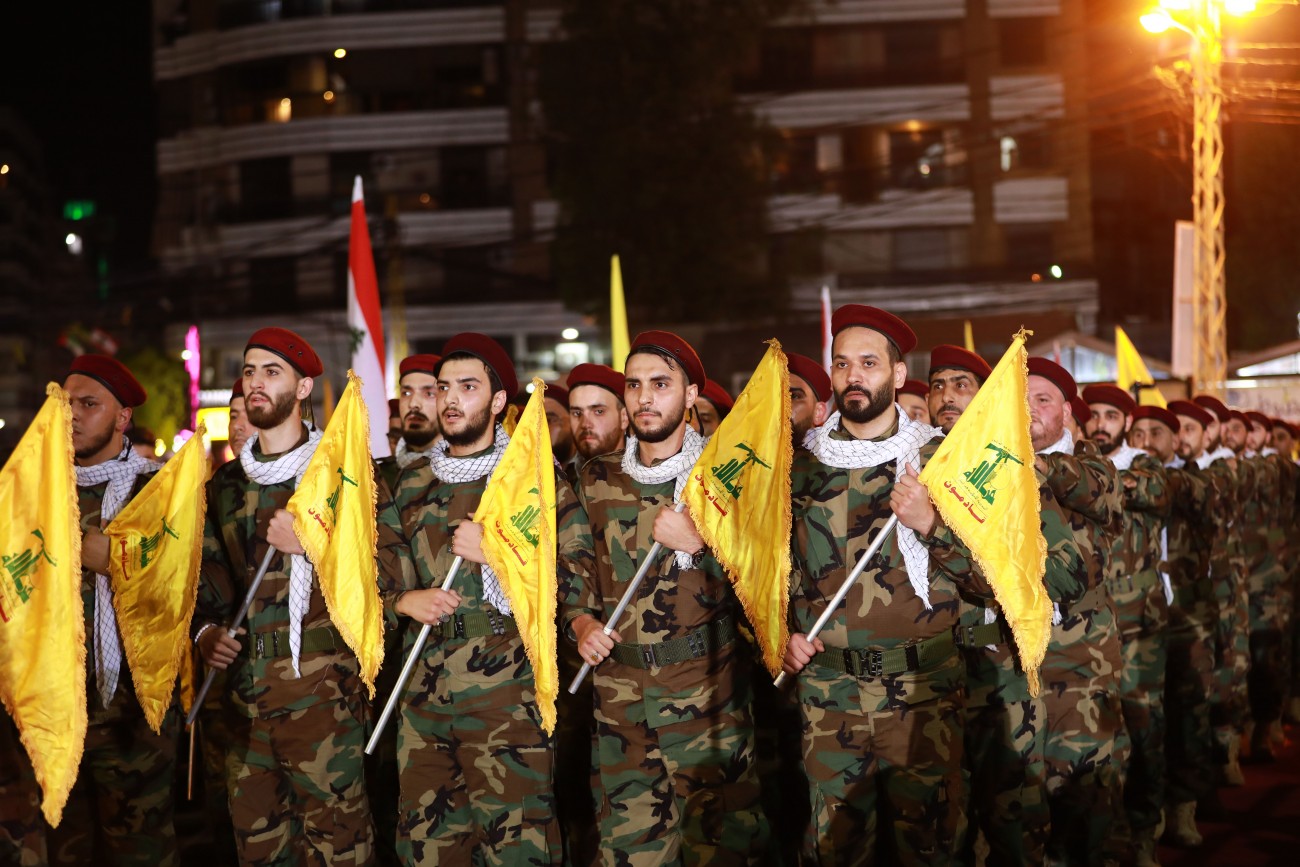

Summary
Deep political, familial, and religious ties have allowed Druze communities across the Levant to remain largely unified against external threats, but eight years of violence in Syria and a coordinated campaign by the regime and its allies now threaten to destabilize regional Druze politics and erode the sect’s political and military power. An Iranian-backed campaign by Hezbollah to incite inter-Druze violence in Lebanon has curtailed this unity, laying the groundwork for Hezbollah to expand into Syria’s Suwayda province with impunity.
Hezbollah’s push to create inter-sect strife has extended from Beirut to the occupied Golan Heights to Suwayda, placing the region’s Druze in a greatly weakened position. This risk is particularly pronounced in Suwayda province, where attempts by Hezbollah and the regime to change the military and political reality on the ground have led to a major shift in power dynamics there, with Hezbollah now affiliated with 60% of armed groups in the province. This paper studies various Hezbollah, Iranian, and Syrian regime attempts to escalate against the Druze political establishment in Israel, Lebanon, and Syria, and the repercussions of these moves across the region.
Key points
- Hezbollah’s power in Suwayda: Approximately 60% of all armed groups in Suwayda province are affiliated with Hezbollah, and it continues to work to recruit or co-opt partners there.
- Iran’s anti-Druze strategy: The Iranian-backed militia group has launched a two-pronged strategy against its enemies within the Druze sect across Lebanon and Syria. In Lebanon, Hezbollah is sowing division between traditional allies and working to dismantle the largest Druze political bloc there, while in Syria it is recruiting a militia of Bedouins and pushing organized crime to promote instability in Suwayda province.
- Hezbollah divides Druze in Lebanon: Hezbollah is leveraging its political allies within the Druze political establishment in Lebanon to isolate and weaken Walid Jumblatt, currently the most prominent Hezbollah and Syrian regime critic among the country’s Druze. Hezbollah grants perks and privileges to Jumblatt’s main rivals, Talal Arslan and Wiam Wahhab.
- Inter-Druze violence in Lebanon: Clashes have erupted between pro- and anti-Jumblatt forces in Lebanon, leading to several deaths. Hezbollah is working to inflame these inter-Druze tensions, which could result in widespread political violence in the Lebanese mountains.
- Occupied Golan Heights: Hezbollah is leveraging its allies in the Golan Heights to further drive wedges between Jumblatt and Druze communities. Hezbollah’s push there comes at a tense and unique time: Hezbollah and the regime have clashed with Israeli forces at the Lebanese-Israeli border in recent weeks, and the controversial passage of a Jewish nationality law in Israel has seen relations between the Druze and Tel Aviv sour since the beginning of the year.
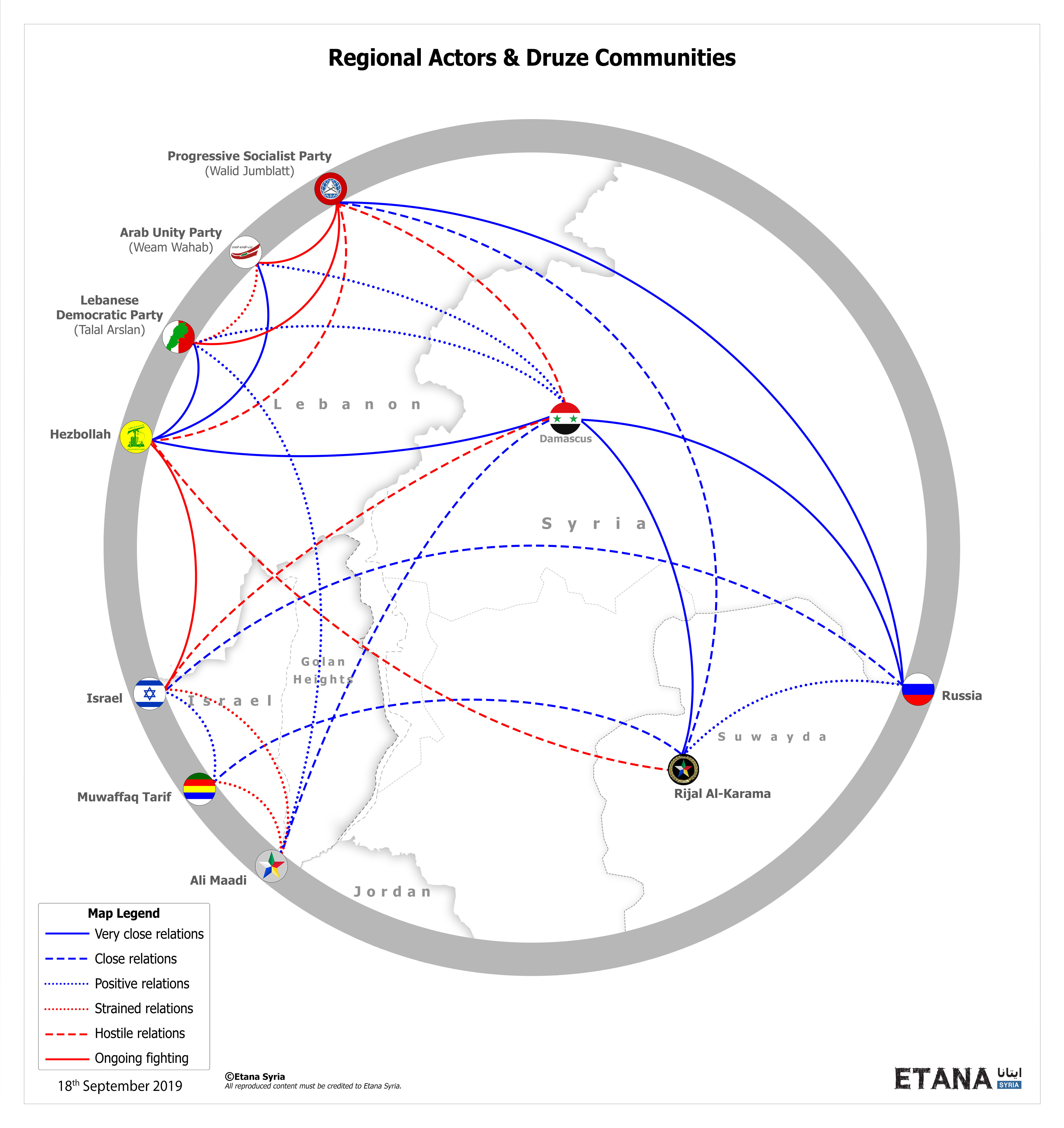
Introduction
The Druze of the Levant region are connected by tribal, familial, and religious ties that have existed for centuries. Despite the borders and political challenges that make even visits to other Druze populations in the region difficult, political figures from Lebanon, Israel, Jordan, and Syria have shared a certain degree of connectedness. Druze leadership from each country confers about major issues, and the Druze of Suwayda, Israel, and Lebanon have maintained close political ties. These ties, however, are now challenged by rising Hezbollah and Assad regime influence in the region as both seek to consolidate power and control in their home countries.
Hezbollah, Iran, and the Syrian regime interact with the Druze political establishment holistically, escalating against Druze figures and entities in Lebanon and Syria in an attempt to tip the balance of power further in their favor. Hezbollah and its allies understand the interconnectedness of the Druze political establishment across the region, and seek to weaken these ties as they push their own local projects to monopolize the political and military landscape.

“Hezbollah and its allies understand the interconnectedness of the Druze political establishment across the region, and seek to weaken these ties as they push their own local projects to monopolize the political and military landscape."
Syria
In Syria, the Druze of Suwayda province have enjoyed more than half a decade of relative autonomy, with the regime largely taking a hands-off approach to local administration and security. The void has been filled by a series of powerful local Druze political and military forces, who wield a great deal of influence in the province. In recent years, Druze community militias have established checkpoints and enacted community policing, and have also clashed with both the regime and ISIS when either group has made incursions into the province. In June, Druze militia forces even drove regime security personnel out of the provincial capital for several hours.
Today, the regime seeks to consolidate its power and authority across the entire country. With the surrender of opposition forces in south-west Syria to the regime in July 2018, Damascus and its security apparatus have increasingly set their sights on Suwayda province and the prominent decision makers there. Recent months have seen an increase in tension between Suwayda and Damascus, along with multiple clashes between Druze militias and pro-regime forces. The most recent major incident came in June, when Druze militia forces attacked the headquarters of regime Air Force Intelligence and drove out regime security personnel from the city for more than 16 hours after an assassination attempt on a local leader. A number of prominent Druze military leaders in the province have been killed or faced assassination attempts, including Sheikhs of Dignity commander Wissam Eid, who was gunned down in a Hezbollah-sponsored attack on May 3.
Hezbollah's local affiliates
The regime, its security forces, and Hezbollah have also worked to co-opt and recruit criminal gangs into their spheres of influence — essentially promoting state-sponsored organized crime in Suwayda in the form of illicit arms and drug smuggling. Recent months have also seen these regime- or Hezbollah-backed gangs engage in targeted kidnappings and vehicle theft, with profits from these operations adding a new stream of revenue to expand these criminal activities.
Hezbollah — and by extension Iran — has established a wide network of political, military, and cultural relationships in Druze areas of Syria as part of a concerted effort to seize control of decision making in Syria and Lebanon. The group has also mobilized its allies within the Lebanese Druze political sphere (Talal Arslan and Wiam Wahhab) to strengthen and entrench its influence in Druze areas of Syria. As a result, 60% of all local armed groups and security forces in Suwayda province are now affiliated with Hezbollah.
A key tenet of Hezbollah’s current strategy in Suwayda is to draw on the power and influence of local Bedouin tribes, launching a massive campaign to recruit fighters from this community into militias under its command. While it has previously recruited Bedouins to bolster its smuggling and other criminal operations along the Syrian-Jordanian border, its current drive to recruit from local Bedouin populations is much wider in scope and in ambition. These Hezbollah-backed Bedouin militias have been recruited in Lajat, eastern Daraa province, and al-Asfar, as well as from within Suwayda province, especially its eastern desert region.
While the stated goal of these newly recruited fighters is to provide local security and protection from ISIS cells, numerous regime and Hezbollah officials on the ground have specifically noted countering Druze militias in Suwayda is their primary focus. Hezbollah is exploiting sectarian and class tensions inflamed after thousands of Sunni Bedouins from Suwayda fled their areas to take refuge in eastern Daraa province following the onset of major fighting in 2012. Hezbollah offers an enticing package to potential Bedouin recruits: a respectable salary, increased influence, and political control in the southwest, as well as the promise of reclaiming one’s homeland after years of exile.
The formation of these Bedouin militias comes amid a Hezbollah and regime withdrawal from numerous positions across the south-west, namely Lajat, eastern Daraa, and eastern Suwayda. Though this withdrawal lines up with former opposition demands in Daraa and Quneitra for regime intelligence forces and Iranian-backed militias to vacate the settlement areas, it signals a transition into a new order where Hezbollah-backed local partners protect and further the militia’s interests in a given area. These moves by Hezbollah lay the foundation for growing sectarian and tribal strife that could potentially translate into violence in the region. If Suwayda were to be engulfed by civil strife, the biggest victors would be Hezbollah and the regime, which could watch from a distance as the Druze militias that protected the region’s semi-autonomy drown in sectarian violence.
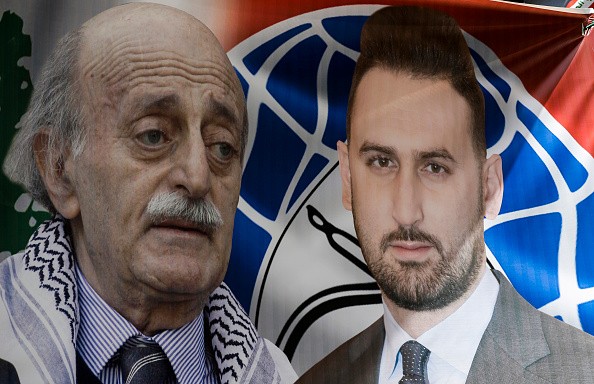
"Jumblatt’s popularity exploded in the early 2000s as a result of his outspoken criticism of the Syrian occupation of Lebanon. Jumblatt has also been a staunch supporter of the Syrian revolution since 2011, and is an advocate for the Druze of Syria.”
Lebanon
Lebanon’s confessional system limits the government positions available to members of the Druze sect, yet the Druze political establishment wields significant sway in the country. In the mountains east of Beirut, multiple prominent Druze political organizations operate and maintain both political and military forces. The most notable Druze figure in Lebanon is Walid Jumblatt, the leading figure within the Progressive Socialist Party (PSP).
Jumblatt’s popularity exploded in the early 2000s as a result of his outspoken criticism of the Syrian occupation of Lebanon. Jumblatt has also been a staunch supporter of the Syrian revolution since 2011, and is an advocate for the Druze of Syria. He has denounced the conscription of Druze in Suwayda province by the regime, accused the Assad regime of allowing ISIS attacks, and has called for Syrian Druze to ally with opposition forces elsewhere in Syria. He enjoys close ties with political leadership in Suwayda, especially with political and military groups hostile to the regime.
Yet Jumblatt’s anti-Damascus activities have seen the aging politician increasingly come under fire from both the Syrian regime and Hezbollah. An intense political rift has developed between the PSP on one side and Hezbollah and its allies on the other, leading to repeated violence. In Lebanon’s Druze communities, Jumblatt and the PSP’s two main rivals are the Arab Unity Party (AUP), led by Wiam Wahhab, and the Lebanese Democratic Party (LDP), led by Talal Arslan. Both the AUP and LDP are pro-Damascus, friendly to Iran, and possess ever-growing ties to Hezbollah.
Hezbollah division
Hezbollah, along with the Syrian regime and Iran, is cultivating deep strategic ties with Druze political leadership in Lebanon, strengthening its influence there by granting its allies in the LDP and AUP privileges and perks while simultaneously working to isolate and alienate Jumblatt and his allies. For Iran in particular, this strategy strengthens and grows its ability to enforce its interests in the region by weakening its opponents there.
Hezbollah has succeeded, by way of its allies in the AUP and LDP, in provoking a series of inter-Druze security incidents east of Beirut. A major goal of Hezbollah and Iran is to fracture the Druze political community in Lebanon and provoke further violence, potentially leading to an outbreak of civil strife in the mountains east of Beirut. The leading Druze religious establishment also fears this eventuality, with the Druze Spiritual Council (DSC) repeatedly expressing its rejection of such violence, denouncing the PSP, LDP, and AUP equally for their roles in these incidents. These neutral statements from the DSC signal a worsening of relations between Jumblatt’s PSP and the DSC, the latter being a traditional supporter of the former.
Hezbollah’s intervention into the Druze political establishment in Lebanon aims to dissolve traditional ties between Druze powers there, specifically by granting additional privileges and benefits to the LDP and AUP at the expense of Jumblatt and the PSP while simultaneously isolating Jumblatt further from the DSC. An added benefit for Hezbollah and the Syrian regime is that, so long as Jumblatt and the PSP are preoccupied by domestic issues in Lebanon, it will be increasingly difficult for him to support his allies in south-west Syria, where his influence has been decreasing since the July 2018 settlement agreement there. This campaign by Hezbollah strikes at a uniquely sensitive time for the PSP and the aging Jumblatt, who, at 79, is preparing to transfer political power to his son, Taymoor Jumblatt. Taymoor is being groomed to head the PSP in the coming years, and is set to take his father’s position in parliament during the next elections. There is currently a discussion within Druze religious leadership about whether or not to continue supporting Jumblatt given the recent changes in the balance of political power in Lebanon.
Security incidents and infighting
Numerous clashes have erupted between Druze factions in the Lebanese mountains since 2018, often with a pro-PSP bloc on one side and a pro-Hezbollah bloc on the other. A table of the most notable clashes is listed below:
| Incident | Date | Belligerents | Description |
|---|---|---|---|
| Al-Chouefat | 5/1/19 | PSP, LDC | Clashes erupted between PSP and LDC supporters in the Druze-majority city of al-Choueifat after a dispute over parliamentary election results. One PSP member was killed in the shootout, which also saw a hand grenade tossed into a PSP building. Two suspects were apprehended, but Jumblatt accused LDC leader Talal Arslan of helping others involved flee to Syria. |
| Al-Jahiliya | 12/1/19 | Lebanese security, AUP | Lebanese security forces and AUP supporters exchanged gunfire in al-Jahiliya, Lebanon, after the former reportedly sent personnel to apprehend AUP head Wiam Wahhab. One AUP supporter was killed in the exchange, and a Lebanese security fighter was injured. The incident led to a political crisis between Prime Minister Saad Hariri and the Hezbollah-backed Wahhab, with both sides offering contradicting narratives of the incident. |
| Qaber Shamoun | 6/30/19 | PSP, LDC | Druze government minister Saleh al-Gharib, a pro-LDC Druze figure, visited the Druze-majority Lebanese mountains and drew protests from PSP supporters. PSP supporters attacked al-Gharib’s convoy, killing 2 aides, after a gun battle between both sides. Both belligerents accused the other of attacking first. Hezbollah announced its solidarity with the LDC following the incident, and publicly rebuked Jumblatt. |
Although tensions have decreased somewhat since the Qaber Shamoun incident, it is highly likely that the situation will deteriorate again unless Hezbollah and Jumblatt can reach some kind of understanding or agreement with one another. Should talks take place between the two sides, Jumblatt is likely to come under great pressure from Hezbollah that could force him to make major concessions in favor of it and Iran. Hezbollah will be able to leverage the threat of an inter-Druze conflict in Lebanon to ensure that Jumblatt restricts his anti-Syrian regime activities and insistence on countering Iran.
Furthermore, if these escalating tensions between rival Druze factions cannot be contained and inter-Druze conflict does erupt on a large scale, Hezbollah will emerge a major victor. As an entity that seeks to use smaller political parties as tools, it will have succeeded in bogging down Jumblatt using violence and reducing his overall influence across the region, especially with the Druze spiritual leadership.
Jumblatt may be inclined to reconcile with Hezbollah given his concerns over the growing regional power of Druze figures in the Golan Heights, where political forces there challenge Jumblatt’s traditional role as the top regional leader of the Druze sect. Individuals like Muwaffaq Tarif in Israel threaten Jumblatt’s current role, and his mounting fears of their ascendency coupled with his desire to protect his family’s political interests could encourage him to reach some kind of understanding with Hezbollah and Iran rather than compromise his political power.

"Strong ties unite the Druze of the Golan Heights with Suwayda. Political, familiar, religious, and tribal bonds keep them linked with their co-religionists in neighboring countries."
Golan Heights
In the Israeli-occupied Golan Heights, a small community of Arab Druze reside in the mountains overlooking Syria, Lebanon, Jordan, and Israel. While some Druze have accepted Israeli citizenship and serve in the Israeli army, many Druze consider themselves occupied Syrians. Although legally barred from visiting Syria by the Israeli government, strong ties unite the Druze of the Golan with Suwayda. Political, familiar, religious, and tribal bonds keep them linked with their co-religionists in neighboring countries. The Golan is also the seat of several influential Druze personalities. Namely, spiritual leader Muwaffaq Tarif, a largely pro-Israeli figure seen as the head of Golan’s Druze, and Ali Maadi, an influential Druze cleric with close ties to Syria who has repeatedly been imprisoned by the Israeli government.
Relations with Suwayda's Druze
The Druze of the Golan have provided genuine military and security support to the Druze of Suwayda on numerous occasions. Prominent Druze figures in the Golan have invested millions of dollars in Suwayda and advocated for increased international support for Syria’s Druze, including support for state-building projects there — though very little of this investment has translated into actual change on the ground.
For now, Hezbollah’s influence on the Golan’s Druze remains indirect, but it could develop into direct confrontation in the near future. Muwaffaq Tarif and his allies support the Druze community militias in Suwayda both politically and militarily, with these militias representing Hezbollah’s first threat and enemy in Suwayda. Hezbollah could leverage its allies in Suwayda to lessen Tarif’s influence, perhaps by propping up the activities of pro-Damascus cleric Ali Maadi. For example, Talal Arslan of Lebanon maintains positive ties with Ali Maadi, who has called for an end to inter-Druze conflict in Lebanon. The regime intelligence apparatus also sees aid from the Golan as partial support from the Israeli government, something that it could work with Hezbollah to disrupt.
Another potential outcome is that Hezbollah will incite a Druze-Bedouin conflict in Suwayda in order to encourage Tarif to cooperate with Hezbollah and its Druze allies in the region, or at least to push them to reduce their role in south-west Syria. This resembles the situation in Beit Jinn during December 2017, when Israeli Druze unified, including Tarif’s block, in support of the villages of Jabal a-Sheikh. Numerous demonstrations took place across Druze regions of Israel to denounce Israel’s support of opposition forces that were attacking the village of Hader at the time. Ali Maadi even called upon Druze in the Golan Heights and elsewhere to desert from the Israeli army due to its support of opposition groups.
Recent months have witnessed a worsening of relations between the Druze and the Israeli government since the passing of the Jewish Nationality Law, enshrining the country as a Jewish state whose official language is Hebrew. Many Druze saw the law as a betrayal, with major demonstrations against it taking place across the country. Tarif told supporters at a rally in Tel Aviv that the Israeli government had ignored the “loyalty” of the Druze, and did not see members of the sect as equals — as evidenced by the passing of the law.
This emerging disconnect between Tel Aviv and the Golan could provide an entry point for Hezbollah to draw support against Israel from Golani Druze. As tensions escalate between Israel and Hezbollah, the latter would benefit from improved ties with the Druze of the Golan.
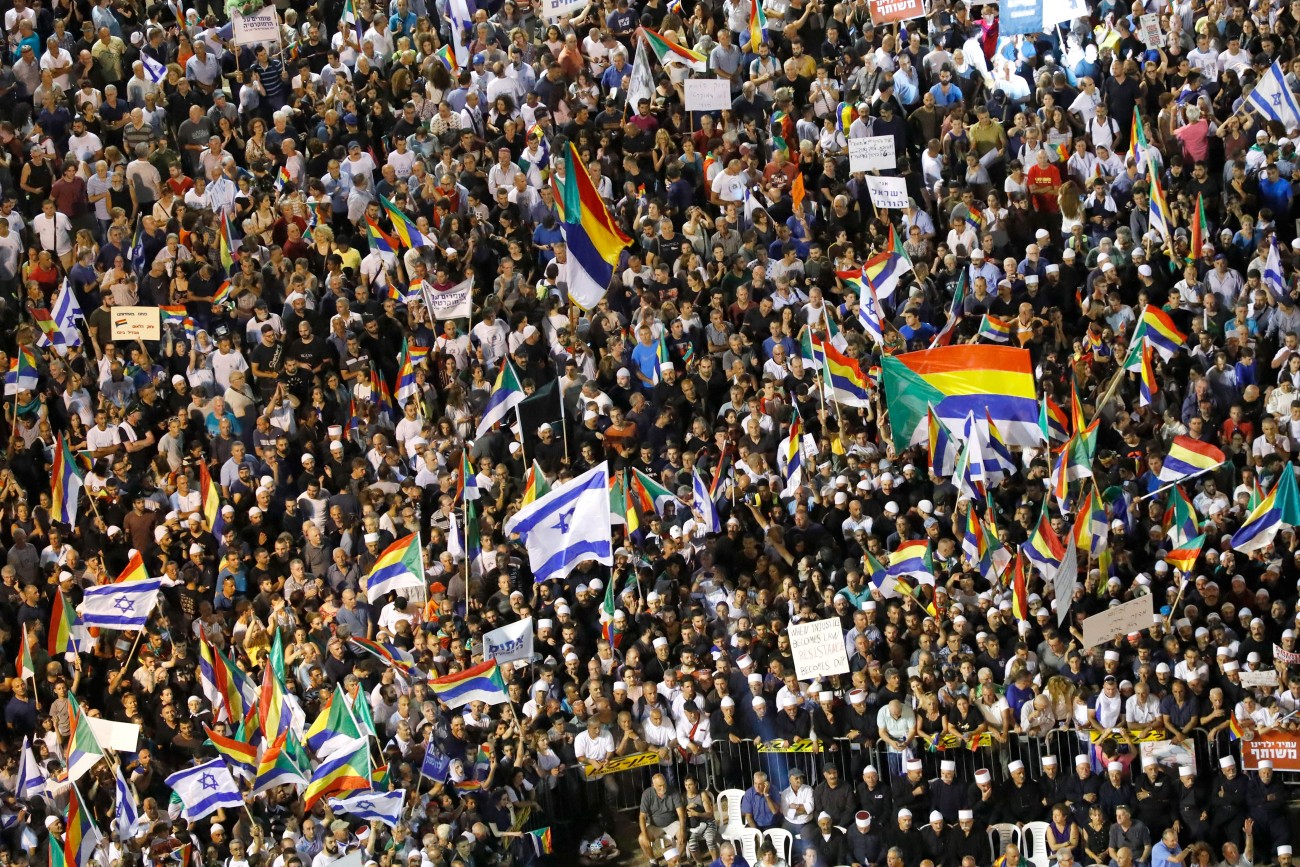
"This emerging disconnect between Tel Aviv and the Golan could provide an entry point for Hezbollah to draw support against Israel from Golani Druze. As tensions escalate between Israel and Hezbollah, the latter would benefit from improved ties with the Druze of the Golan.”
Conclusion
Hezbollah is leading an Iranian-backed charge against the Druze sect across Lebanon, Syria, and Israel. Its assault has a broad focus and seeks to break down the cross-border ties that unify the sect’s members across the region.
In south-west Syria, Hezbollah is recruiting Bedouin fighters to build militias capable of countering Druze military and political power in Suwayda province. This recruitment coincides with the formation of smuggling, kidnapping, and assassination gangs currently promoting instability and organized crime in the region. Hezbollah is seeking to dismantle the current political order in Suwayda, potentially drowning the province in a major Bedouin-Druze conflict.
Hezbollah is sowing division in the Druze political establishment in Lebanon. As it works to consolidate its power in the country, Hezbollah is building ties with Druze groups hostile to Walid Jumblatt’s party, the largest Druze political entity there. Jumblatt has long been an outspoken critic of the Syrian regime, Iran, and Hezbollah, and the latter aims to curb his political power. These heightened tensions between rival Druze blocs have turned bloody on several occasions in the past year, and could expand into widespread political violence in the Lebanese mountains.
Relations between Druze and the Israeli government are uniquely strained, and Hezbollah is likely to leverage its allies there in order to expand its influence in the occupied Golan Heights.
As ties between Druze groups across the region weaken, their ability to interact with and support one another across borders also weakens. This is particularly important for Hezbollah’s activities in Suwayda province, where prominent figures in Lebanon like Walid Jumblatt and others in Israel like Muwaffaq Tarif wield tremendous influence.
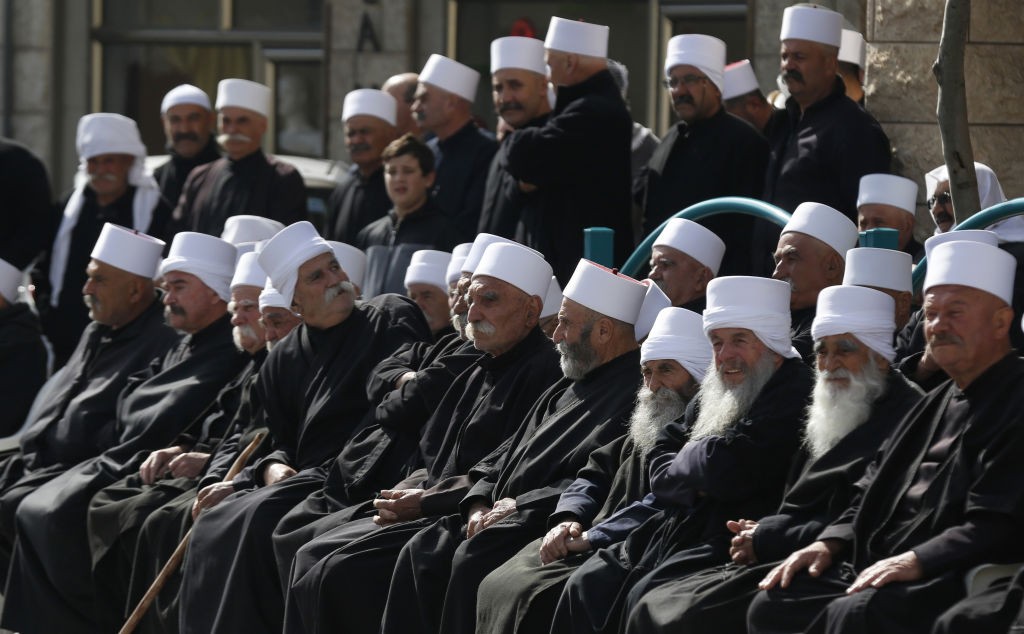
"Hezbollah is leading an Iranian-backed charge against the Druze sect across Lebanon, Syria, and Israel. Its assault has a broad focus and seeks to break down the cross-border ties that unify the sect’s members across the region."
Photos
1. Druze men in the Israeli-annexed Golan Heights look out across the southwestern Syrian province of Quneitra, visible across the border on July 7, 2018 (Photo by JALAA MAREY/AFP/Getty Images)
2. Fighters with Hezbollah carry flags as they parade in a southern suburb of Beirut to mark Quds Day, on May 31, 2019. (Photo by ANWAR AMRO/AFP/Getty Images)
3. Druze elders in Beirut, Lebanon. (Photo by Eric BOUVET/Gamma-Rapho via Getty Images)
4. A banner of Lebanese candidate for the upcoming parliamentary elections featuring Taymoor Jumblatt (R) and his father Walid Jumblatt (L) hanging in a street in Beirut. (Photo by JOSEPH EID/AFP/Getty Images)
5. Druze residents of the Israeli-annexed Golan Heights gather under a huge Syrian national flag during a rally held in the Druze village of Majdal Shams on April 17, 2019 to mark Syria's Independence Day. (Photo by JALAA MAREY/AFP/Getty Images)
6. Members of the Israeli Druze community and their supporters wave their flags as they demonstrate during a rally to protest against the 'Jewish Nation-State Law' in the Israeli coastal city of Tel Aviv on August 4, 2018. (Photo by JACK GUEZ/AFP/Getty Images)
7. Druze residents of the Golan Heights rally in the village of Majdal Shams on February 14, 2018 to protest against the 1981 Israeli annexation law of the strategic plateau which the Israel captured from Syria during the 1967 Arab-Israeli war. (Photo by JALAA MAREY/AFP/Getty Images)
Methodology
ETANA maintains extensive networks of sources across Syria and within Syria's neighboring countries which it uses to gather and cross-verify information. Data gathered is analyzed by civil, political, and military experts to understand relations and conditions and recognize trends. Maps produced are visual representations of verified data.
About the Middle East Institute
The Middle East Institute is a center of knowledge dedicated to narrowing divides between the peoples of the Middle East and the United States. With over 70 years’ experience, MEI has established itself as a credible, non-partisan source of insight and policy analysis on all matters concerning the Middle East. MEI is distinguished by its holistic approach to the region and its deep understanding of the Middle East’s political, economic and cultural contexts. Through the collaborative work of its three centers — Policy & Research, Arts & Culture and Education — MEI provides current and future leaders with the resources necessary to build a future of mutual understanding.
About ETANA Syria
ETANA, a Syrian organization established in Damascus in 2001, is committed to achieving a democratic, inclusive future for all Syrians. Since the onset of the Syrian crisis, ETANA has worked to find a sustainable political solution by building linkages and accountability between local communities, as well as the international community. It focuses on providing accurate reporting and analysis of the situation on the ground in Syria, which has proven vital to achieving coherent Syria policy. Follow ETANA’s work on Twitter @ETANA_Syria.












